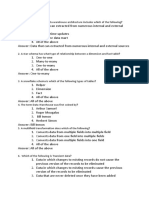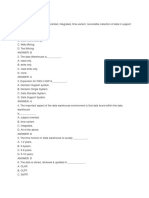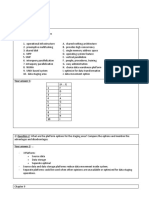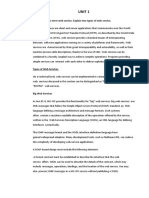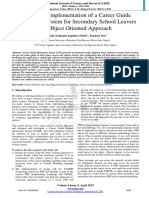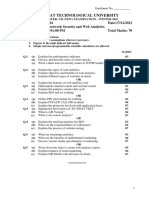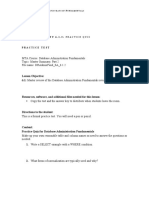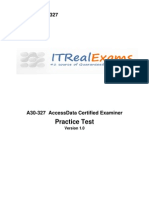1 Mark Questions
Note: Asterik (*) Indicates the repeatation in previous years exam papers.
Full Forms
Chapter-1
OLTP - Online Transaction Processing **
OLAP - Online Analytical Processing **
CRM - Customer Relationship Management **
ODS - Operational Data Store
ERP - Enterprise Resource Planning
NDS - Normalized Data Store
DWH - Data Ware House
SOA - Service-Oriented Architecture
EDW - Enterprise Data Warehouse
Chapter-2
SCD - Slowly Changing Dimensions
Chapter-3
SSIS - SQL Server Integration Services ****
ETL - Extract, Transform, Load ****
SSDT - SQL Server Data Tools *
SMO - SQL Server Management Objects
Chapter-4
DQS - Data Quality Services **
DQAF - Data Quality Assessment Framework
DQKB - Data Quality Knowledge Base
DQM - Data Quality Management
Chapter-5
SSAS - SQL Server Analysis Services ****
SSRS - SQL Server Reporting Services ***
BI - Business Intelligence
BIML - Business Intelligence Markup Language
Questions
Chapter-1
(1) What is Multidimensional data store?
Ans: A Multidimensional Data Store is a type of data storage used in OLAP (Online
Analytical Processing) systems, where data is stored in a multi-dimensional structure instead
of traditional rows and columns.
It allows data to be analyzed from multiple perspectives, using dimensions (e.g., time,
location, product) and facts (e.g., sales, revenue).
(2) What is data Warehouse?
Ans: A Data Warehouse is a centralized repository that stores integrated, historical, and
structured data from multiple sources for analysis and reporting.
Chapter-2
(1) List out types of entity relationship.
Ans: The types of Entity Relationships are:
1. One-to-One (1:1)
2. One-to-Many (1:M)
3. Many-to-One (M:1)
4. Many-to-Many (M:M)
(2) Where Fact table is located in the database? *
Ans: The Fact Table is located at the center of a Star Schema or Snowflake Schema in a Data
Warehouse, surrounded by Dimension Tables.
(3) What is snowflake schema?
Ans: A Snowflake Schema is a type of database schema in a Data Warehouse where
dimension tables are normalized into multiple related tables to reduce redundancy. It
improves storage efficiency but increases query complexity.
(4) What is a star schema? **
Ans: A Star Schema is a type of database schema in a Data Warehouse where a central fact
table is directly connected to denormalized dimension tables, forming a star-like structure.
It simplifies queries and improves performance.
(5) Fact table contain only Numeric facts. (True/ False)
Ans: False.
A Fact Table primarily contains numeric facts (measures) but also includes foreign keys
linking to dimension tables.
(6) Where Dimension Table is located in the database?
Ans: The Dimension Table is located around the Fact Table in a Star Schema or Snowflake
Schema in a Data Warehouse. It stores descriptive attributes related to facts.
(7) What is role playing dimension?
Ans: A Role-Playing Dimension is a single dimension table that is used for multiple
purposes in a fact table by having different roles.
Example: A Date Dimension can be used as Order Date, Ship Date, and Delivery Date in the
same fact table.
(8) What is fact table? *
Ans: A Fact Table is a table in a Data Warehouse that stores measurable business data
(facts) and contains foreign keys linking to dimension tables. It is used for analytical
reporting.
(9) What is data warehouse schema?
Ans: A Data Warehouse Schema is the logical structure that defines how data is organized
in a Data Warehouse. It includes fact tables, dimension tables, and their relationships.
Common types: Star Schema, Snowflake Schema, and Galaxy Schema.
(10) What is attribute?
Ans: An Attribute is a property or characteristic of an entity in a database.
Example: In a Customer entity, attributes can be Customer_ID, Name, Email, and Phone
Number.
(11) What is schema?
Ans: A Schema is the logical structure of a database that defines how data is organized,
including tables, attributes, relationships, and constraints.
(12) What is dimension?
Ans: A Dimension is a structure in a Data Warehouse that provides descriptive context for
facts by categorizing and organizing data.
Example: Time, Product, Customer, and Location are common dimensions.
Chapter-3
(1) List out container Control in SSDT. *
Ans: The Container Controls in SQL Server Data Tools (SSDT) for SSIS (SQL Server
Integration Services) are:
1. Sequence Container
2. For Loop Container
3. Foreach Loop Container
4. Task Host Container
(2) In SSIS, Extension of Packages is _ _ _ _ _ _ _ _ _ _ _ .
Ans: In SSIS (SQL Server Integration Services), the extension of packages is .dtsx .
(3) What is extraction?
Ans: Extraction is the process of retrieving data from multiple source systems (databases,
files, APIs, etc.) to load it into a Data Warehouse for analysis. It is the first step in the ETL
(Extract, Transform, Load) process.
(4) _ _ _ _ _ _ _ area is required in ETL load.
Ans: A Staging area is required in ETL Load to temporarily store extracted data before
transformation and loading into the Data Warehouse.
Chapter-4
(1) List out DQS Components. *
Ans: The DQS (Data Quality Services) Components are:
1. Data Quality Server
2. Data Quality Client
3. Knowledge Base
4. Data Quality Projects
5. DQS Cleansing Transformation (in SSIS)
(2) How many types of project provide by DQS client? List out it.
Ans: The DQS (Data Quality Services) Client provides three types of projects:
1. Cleansing – Improves data quality by correcting and standardizing data.
2. Matching – Identifies and removes duplicate records.
3. Profiling – Analyzes data quality issues in a dataset.
(3) What Is Data Profiling? **
Ans: Data Profiling is the process of analyzing, examining, and summarizing data to assess
its quality, consistency, and structure before loading it into a Data Warehouse.
(4) What is Data Cleansing?
Ans: Data Cleansing is the process of identifying and correcting errors, inconsistencies, and
inaccuracies in data to improve its quality and reliability for analysis.
(5) What is Data matching in DQS?
Ans: Data Matching in DQS (Data Quality Services) is the process of identifying and
eliminating duplicate records by comparing data based on defined matching rules and
thresholds.
(6) Which tab is used to display a list of the rules in the matching policy and the conditions in
a rule?
Ans: The Matching Policy tab in DQS (Data Quality Services) is used to display a list of the
rules in the matching policy and the conditions in a rule.
Chapter-5
(1) List out type of Authentication to Connect SQL Server. *
Ans: The types of Authentication to connect to SQL Server are:
1. Windows Authentication
2. SQL Server Authentication
3. Azure Active Directory Authentication
4. Certificate-Based Authentication
(2) Each Cube has one or more Dimensions. (True/ False)
Ans: True.
Each Cube in a Data Warehouse has one or more Dimensions that provide descriptive
context for the data stored in fact tables.
(3) Extension of Reports is _ _ _ _ _ _ _ _ _ .
Ans: The extension of reports in SQL Server Reporting Services (SSRS) is .rdl (Report
Definition Language).
(4) What is package?
Ans: A Package in SSIS (SQL Server Integration Services) is a collection of tasks, workflows,
connections, and control flow elements used to perform ETL (Extract, Transform, Load)
operations. It is saved with the .dtsx extension.
(5) How many types of deployment models are available?
Ans: There are two types of deployment models in SSIS (SQL Server Integration Services):
1. Project Deployment Model – Deploys the entire project to the SSIS catalog.
2. Package Deployment Model – Deploys individual packages separately.
(6) What is data analysis?
Ans: Data Analysis is the process of inspecting, cleaning, transforming, and modeling data
to extract meaningful insights, identify patterns, and support decision-making.














